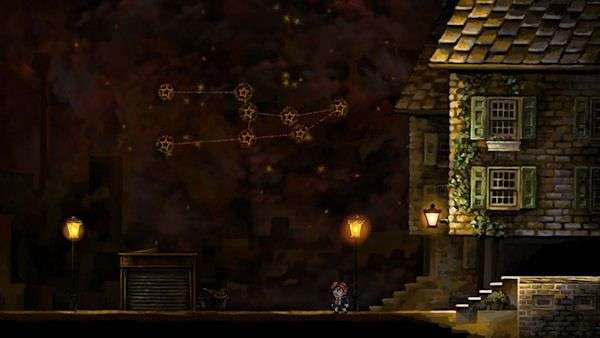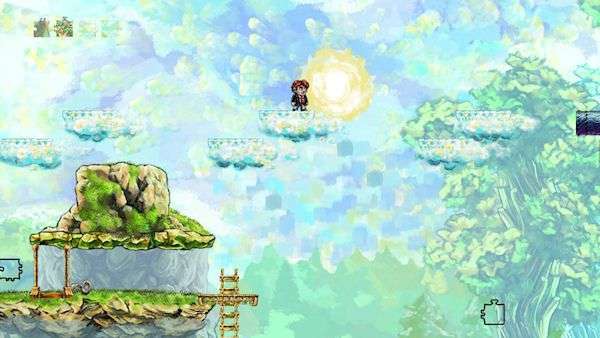Braid Preview Xbox Live Arcade, PC

Let it be known that, at the time of writing, I envy every single person who reads this preview. Why? Because I’ve just started up Jonathan Blow’s Braid for the first time, and I’ll never get to do it again. I’ll be able to play it again, sure, but it won’t ever be the same as it was just now. I can’t, unlike the game’s protagonist, rewind time and have the same experience again.
Fifteen minutes. That’s how long I spent on Braid’s title/level-select screen. Well, calling it a ‘screen’ isn’t totally fair – it’s a small environment for you to run around in, about three screens in size. Not that there’s a lot to do here – there isn’t – but it’s just a nice place to be. I could’ve run ahead and started the game proper, sure. But I was quite happy where I was, staring at a blurry, glowing cityscape while absorbing the absolutely stunning soundtrack.
Still, let’s take the wank-hat off for a minute. What’s Braid about?
Put simply, it’s a puzzle-based 2D platformer where you can rewind time, due out on Xbox Live Arcade within the next few months, with a PC release to follow. And yet, while comparisons to Prince of Persia or Blinx: The Time Sweeper will inevitably be made, they are wholly unfair. It’s certainly true that Braid takes a lot of familiar elements from previous games in order to ease the player in and avoiding pissing you off – but there is no denying that you haven’t played anything quite like this before. The main reason for this is that within each of the game’s worlds, time itself behaves differently. While your own time-manipulation abilities barely extend beyond your ‘rewind’ button, the things you can do just by bending each level’s rules to your whim is absolutely incredible.

The puzzles start off simple – early on, the game introduces objects that exist ‘outside’ of time, and aren’t affected by your rewinding – they travel along a set path no matter what you do, or try to undo. Several worlds later, you’re co-ordinating movements with an alternate-reality self whose actions you set up to interact alongside your own by acting those actions out yourself, then rewinding time. You watch your ‘old’ self act out what you just did, whilst also doing stuff in the present in order to solve the current puzzle. If you’re unsure of what I mean, check the video below – although be warned, solving puzzles is the whole point of the game, so give the video a miss if you’re keen to avoid spoilers.
httpv://www.youtube.com/watch?v=iFrTjlkpdbM
Of course, if you want to just run through all of Braid’s levels without testing yourself, you can. You don’t have to solve the puzzles if you don’t want to. But if you don’t, you’re missing the point, and you won’t get the full reward. Solving each of the game’s puzzles earns you a jigsaw piece for that world – each world contains twelve pieces that make up a picture representing that level’s theme. Solve all the jigsaw puzzles, and you’ll be granted access to the game’s final world.

Right, wank-hat back on. Playing Braid reminded me of something I read a few years back. It was an article about some Xbox 360 press event, with some over-enthusiastic Microsoft employee harping on about how the hi-def era was going to bring us “the Zen of videogaming”. His idea of this ‘Zen’ essentially boiled down to having a massive telly with a highly-detailed picture on it, which apparently leads to a more immersive experience. He might be right about that, but he sure as hell didn’t understand what Zen is. Braid – intentionally or otherwise – does.
Let me explain – Braid is a really hard game. At least, it is if you’re as thick as I am. Yet it’s not frustrating in the least, and doesn’t really require a massive amount of skill. The clever thing about the game is the way it forces you to think in ways you hadn’t considered before. We’re not used to being able to manipulate time in the ways that Braid allows you to, and it’s remarkably difficult to get your head around at first. You can sit staring at it for hours, feeling entirely clueless as to how the next jigsaw piece could even be possible to reach. But with a bit of patience, everything just clicks, and you can’t help but smile to yourself at how elegantly simple the whole thing is. It was never difficult at all – you just weren’t thinking in the right way. That’s videogaming Zen.

I haven’t even started ranting about the gorgeous art style, the wonderful story, or the incredible attention to detail in the game’s time manipulation, in both aesthetic and gameplay terms. But this is only a preview, so I’d better save some stuff to talk about, eh?
Mind you, if you’d rather not wait for our review when the game actually comes out, just stick ‘9/10’ on the end of this preview and you’re basically there.